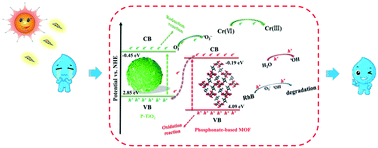Construction of novel phosphonate-based MOF/P–TiO2 heterojunction photocatalysts: enhanced photocatalytic performance and mechanistic insight†
Abstract
Development of highly efficient photocatalysts for photocatalysis research has been a hot research area in recent years. Herein, the phosphate-based metal organic framework (MOF)/P–TiO2 hybrid composites (MOFx/P–TiO2) were first synthesized using the phosphonate-based MOF [Cd(H2L)]n (H4L = 2,5-dimethylbenzene-1,4-diylbis(methylene)diphosphonic acid) and phosphated mesoporous TiO2 beads (P–TiO2) using a versatile step-by-step self-assembly strategy for environmental remediation. The results showed that the Cd-MOF loading content in the MOFx/P–TiO2 has an important influence on the degradation of pollutants, and the hybrid materials could significantly enhance the photocatalytic activity for the photo-oxidative degradation of RhB (97.6% in 25 min over MOF1.5/P–TiO2) and the reduction of Cr(VI) (96.1% in 60 min over MOF0.5/P–TiO2) in comparison with the single-component Cd-MOF or P–TiO2. The enhancement of the photocatalytic activity of MOFx/P–TiO2 could be mainly attributed to: (i) the strong light absorption capacity, and (ii) the effective photogenerated charge separation and transfer through the coupled heterojunction interfaces of P–TiO2 and Cd-MOF. Furthermore, the results verified that the matched band structure of P–TiO2 and Cd-MOF could induce a superfast Z-scheme interfacial charge transfer path. Therefore, a reasonable Z-scheme charge transfer mechanism was proposed based on the active species trapping experiments and the results of electron spin resonance (ESR). More importantly, MOF0.5/P–TiO2 and MOF1.0/P–TiO2 possess a good stability and reusability after recycling five times owing to the high chemical stability of the Cd-MOF, P–TiO2 and heterojunctions. The present work provides a promising approach to construct direct Z-scheme porous heterojunctions for elimination of environmental pollutants.



 Please wait while we load your content...
Please wait while we load your content...